NVIDIA GeForce GTX 670 Review Feat. EVGA: Bringing GK104 Down To $400
by Ryan Smith on May 10, 2012 9:00 AM ESTCompute
Shifting gears, as always our final set of benchmarks is a look at compute performance. As we have seen with GTX 680, GK104 appears to be significantly less balanced between rendering and compute performance than GF110 or GF114 were, and as a result compute performance suffers. Cache and register file pressure in particular seem to give GK104 grief, which means that GK104 can still do well in certain scenarios, but falls well short in others.
Our first compute benchmark comes from Civilization V, which uses DirectCompute to decompress textures on the fly. Civ V includes a sub-benchmark that exclusively tests the speed of their texture decompression algorithm by repeatedly decompressing the textures required for one of the game’s leader scenes. Note that this is a DX11 DirectCompute benchmark.
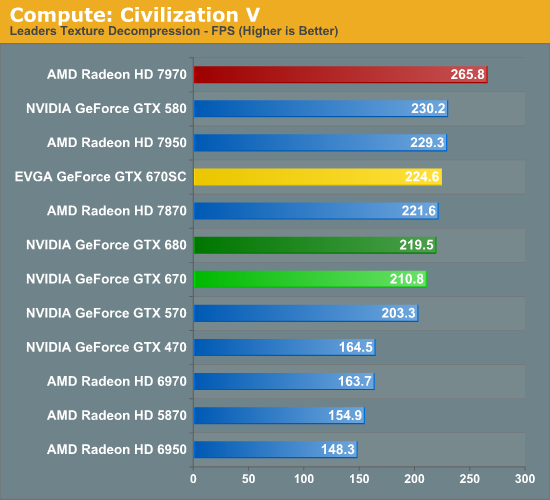
It’s quite shocking to see the GTX 670 do so well here. For sure it’s struggling relative to the Radeon HD 7900 series and the GTX 500 series, but compared to the GTX 680 it’s only trailing by 4%. This is a test that should cause the gap between the two cards to open up due to the lack of shader performance, but clearly that this not the case. Perhaps we’ve been underestimating the memory bandwidth needs of this test? If that’s the case, given AMD’s significant memory bandwidth advantage it certainly helps to cement the 7970’s lead.
Our next benchmark is SmallLuxGPU, the GPU ray tracing branch of the open source LuxRender renderer. We’re now using a development build from the version 2.0 branch, and we’ve moved on to a more complex scene that hopefully will provide a greater challenge to our GPUs.
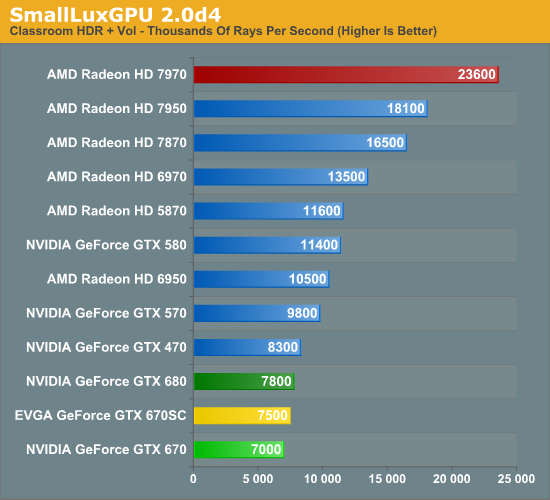
SmallLuxGPU on the other hand finally shows us that larger gap we’ve been expecting between the GTX 670 and GTX 680. The GTX 680’s larger number of SMXes and higher clockspeed cause the GTX 670 to fall behind by 10%, performing worse than the GTX 570 or even the GTX 470. More so than any other test, this is the test that drives home the point that GK104 isn’t a strong compute GPU while AMD offers nothing short of incredible compute performance.
For our next benchmark we’re looking at AESEncryptDecrypt, an OpenCL AES encryption routine that AES encrypts/decrypts an 8K x 8K pixel square image file. The results of this benchmark are the average time to encrypt the image over a number of iterations of the AES cypher.
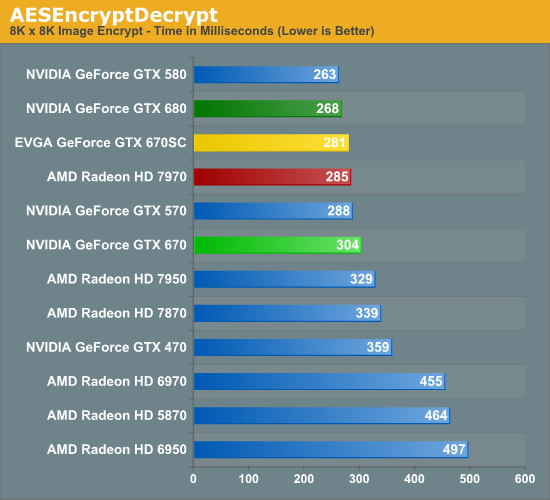
Once again the GTX 670 has a weak showing here, although not as bad as with SmallLuxGPU. Still, it’s enough to fall behind the GTX 570; but at least it’s enough to beat the 7950. Clockspeeds help as showcased by the EVGA GTX 670SC but nothing really makes up for the missing SMX.
Our foruth benchmark is once again looking at compute shader performance, this time through the Fluid simulation sample in the DirectX SDK. This program simulates the motion and interactions of a 16k particle fluid using a compute shader, with a choice of several different algorithms. In this case we’re using an (O)n^2 nearest neighbor method that is optimized by using shared memory to cache data.
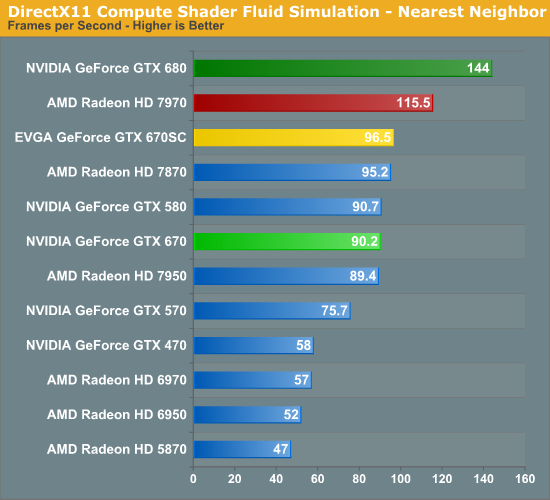
For reasons we’ve yet to determine, this benchmark strongly dislikes GTX 670 in particular. There doesn’t seem to be a performance regression in NVIDIA’s drivers, and there’s not an incredible gap due to TDP, it just struggles on the GTX 670. As a result performance of the GTC 670 only hits 42% of the GTX 680, which is well below what the GTX 670 should theoretically be getting. Barring some kind of esoteric reaction between this program and the unbalanced GPC a driver issue is still the most likely culprit, but it looks to only affect the GTX 670.
Finally, we’re adding one last benchmark to our compute run. NVIDIA and the Folding@Home group have sent over a benchmarkable version of the client with preliminary optimizations for GK104. Folding@Home and similar initiatives are still one of the most popular consumer compute workloads, so it’s something NVIDIA wants their GPUs to do well at.
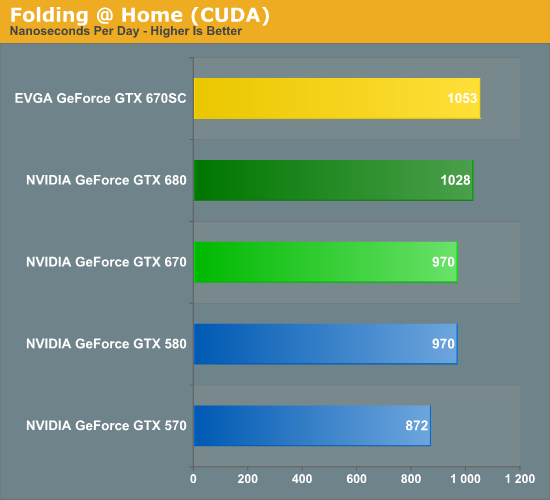
Whenever NVIDIA sends over a benchmark you can expect they have good reason to, and this is certainly the case for Folding@Home. GK104 is still a slouch given its resources compared to GF110, but at least it can surpass the GTX 580. At 970 nanoseconds per day the GTX 670 can tie the GTX 580, while the GTX 680 can pull ahead by 6%. Interestingly this benchmark appears to be far more constrained by clockspeed than the number of shaders, as the EVGA GTX 670SC outperforms the GTX 680 thanks to its 1188MHz boost clock, which it manages to stick to the entire time.










414 Comments
View All Comments
SlyNine - Saturday, May 12, 2012 - link
I'm starting to think you're alittle crazy.CeriseCogburn - Sunday, May 13, 2012 - link
Say it 3 more times ( as you have already), it certainly invalidates all the reasons why the amd card loses badly.Nice, desperate try there. Not.
medi01 - Friday, May 11, 2012 - link
Let me guess: because you can actually get either 680 or 670 at the announced price (if at all), eh?So you can't? And when you will be able to get one, street price would probably be higher than MSRP, eh?
So what are you buzzing about?
CeriseCogburn - Friday, May 11, 2012 - link
Oh that's too bad, you're wrong again. 670 still 399 at the egg.Order, go ahead in STOCK.
How about someone ban you for just being a smart aleck, isn't that what a zealout of no use whatsoever really is ? Are you going to claim this is your joke and rip on others place ? Why didn't you check availability or read about it in the article the reviewer in fact went into quite some detail and extrapolation on the differences between this and the 680 and 690, but you never read the review did you ?
You just come here to attack others and smart off for amd points.
SlyNine - Saturday, May 12, 2012 - link
I got a GTX680 for 499$, but still he needs to chill. If someone bought a 7970 before the 670GTX came out it might have been the fast card they could find for the money.Not counting dual GPU solutions of course ( I hate those).
CeriseCogburn - Sunday, May 13, 2012 - link
I wonder who that someone would be, yours truly.I guess your comprehension skills are not really up to par.
Spunjji - Friday, May 11, 2012 - link
Trololol "viral marketing group". xDHe's just pissed off because he thinks the other side are getting paid for being mindless bigots...
CeriseCogburn - Friday, May 11, 2012 - link
No it's clear none of you are being paid a dime, not even a single housefire amd 7970 woodscrew.CeriseCogburn - Friday, May 11, 2012 - link
This should make the amd fans happy, immense amd bias by the reviewer, again.TWS2
" The GTX 570 and it’s increasingly puny 1.25GB of RAM can’t even run this game with our 2560 benchmark settings "
What the reviewer forgets to mention is that at 2560 and their benchmark settings not a single card present is playable, all under 29 fps and the majority under 20.
ROFL
That might be entirely different without the new game patch bug that affects only nVidia, but the very fact that the reviewer moans about "the 570" "puny ram" problem while noting a COMPLETELY UNPLAYABLE GAME BENCHMARK FROM THE HIGHEST TIERED 3G RAM AMD FLAGSHIP CARD...
Where exactly is the brain ?
This is the kind of crap we have to put up with here, at least we who have a brain and can see what's going on.
I guess the amd fanboys can thank the reviewer for further perpetuation of the ram bottleneck MYTH.
What a JOKE ATTACK on the nVidia card.
Worse yet, on the very next page, the very same GTX570 beats the amd opposition 2G ram 7870 at 2560 but it can't be mentioned.
SlyNine - Saturday, May 12, 2012 - link
lol, the 7970 runs it at 28. Which is playable in a game like that.Funny the 7970 is by far more playable at that res. thanks for pointing that out.
Of course once Nvidia fixes the bug they should rerun the test.